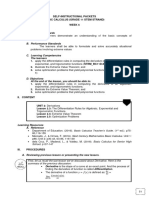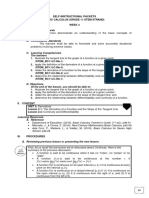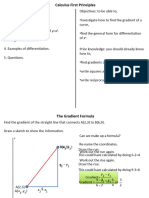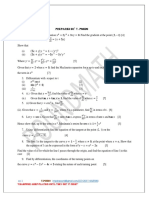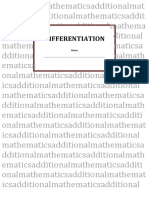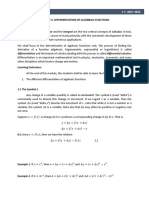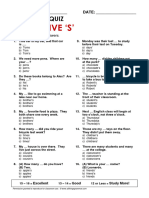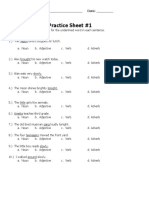Differentiation Notes
Uploaded by
tonychisenga05Differentiation Notes
Uploaded by
tonychisenga05DIFFERENTIATION COMPILED BY T.
PONDO
We are familiar with finding the gradient of straight lines. The gradient of a straight line is the
measure of how steep the line is. However we can as well find the gradient of a curve . Unlike a
line which has constant steepness/gradient, a curve has no constant steepness hence there is need
to find the gradient function of a particular curve. The process of finding the gradient function is
called DIFFERENTIATION
Drawing a tangent by hand and measuring the gradient is a time consuming and inaccurate. Instead we
consider another point on 𝑓(𝑥) ,point Q,and draw ain the line joining P and Q. This line is called a chord.
The point Q has x-coordinate, 𝑥 = 𝑎 + ℎ. The gradient of the chord is approximately equal to the gradient
at P.
𝑐ℎ𝑎𝑛𝑔𝑒 𝑖𝑛 𝑓(𝑥)
The gradient of the chord PQ = 𝑐ℎ𝑎𝑛𝑔𝑒 𝑖𝑛 𝑥
Imagine the point Q slides down 𝑓(𝑥) so that it is closer to P,i.e h decreases. The closer Q gets to P, the
closer the gradient of the tangent at P. We say that ‘in the limit as h tends to zero’ , the gradient of the
chord PQ equals the gradient of the tangent at P. As h is made arbitrarily small, so Q and P arbitrarily
close together,the gradient of PQ becomes arbitrarily close to the gradient of the tangent at P and we write
𝒇(𝒙 + 𝒉) − 𝒇(𝒙)
𝒇′(𝒙) = 𝐥𝐢𝐦
𝒉→𝟎 𝒉
𝑑𝑦
𝑓 ′𝑥 = which is the derivative of y with respect with respect to x.
𝑑𝑥
It is also known as the gradient function
pg. 1 T.PONDO (tripahpound@gmail.com/////+263774815580)
‘CHAMPIONS KEEP PLAYING UNTIL THEY GET IT RIGHT’
Example 1
Find the derivative of y w r t x of
a. 𝑦 = 5𝑥 + 3
b. 𝑦 = 3𝑥 2 + 2
c. 𝑦 = 𝑥 2 − 2𝑥 + 4
1
d. 𝑦= 2
𝑥
Solution 1a.
Let 𝑦 = 𝑓(𝑥)
𝑓(𝑥 + ℎ) − 𝑓(𝑥)
𝑓′(𝑥) = lim
ℎ→0 ℎ
(5(𝑥 + ℎ) + 3) − (5𝑥 + 3)
= 𝑓′(𝑥) = lim
ℎ→0 ℎ
5𝑥 + 5ℎ + 3 − 5𝑥 − 3
𝑓′(𝑥) = lim
ℎ→0 ℎ
5ℎ
𝑓′(𝑥) = lim
ℎ→0 ℎ
𝑓′(𝑥) = lim 5 = 5
ℎ→0
𝑑𝑦
∴ =5
𝑑𝑥
Solution 1b.
𝑓(𝑥 + ℎ) − 𝑓(𝑥)
𝑓′(𝑥) = lim
ℎ→0 ℎ
3(𝑥 + ℎ)2 + 2 − (3𝑥 2 + 2)
𝑓′(𝑥) = lim
ℎ→0 ℎ
3(𝑥 2 + 2𝑥ℎ + ℎ2 ) + 2 − 3𝑥 2 − 2
𝑓′(𝑥) = lim
ℎ→0 ℎ
(3𝑥 2 + 6𝑥ℎ + 3ℎ2 ) + 2 − 3𝑥 2 − 2
𝑓′(𝑥) = lim
ℎ→0 ℎ
6𝑥ℎ + 3ℎ2
𝑓′(𝑥) = lim
ℎ→0 ℎ
ℎ(6𝑥 + 3ℎ)
𝑓′(𝑥) = lim
ℎ→0 ℎ
𝑓′(𝑥) = lim 6𝑥 + 3ℎ
ℎ→0
𝑓′(𝑥) = 6𝑥
pg. 2 T.PONDO (tripahpound@gmail.com/////+263774815580)
‘CHAMPIONS KEEP PLAYING UNTIL THEY GET IT RIGHT’
𝑑𝑦
∴ = 6𝑥
𝑑𝑥
Solution 1c.
Let 𝑓(𝑥) = 𝑥 2 − 2𝑥 + 4
𝑓(𝑥 + ℎ) − 𝑓(𝑥)
𝑓′(𝑥) = lim
ℎ→0 ℎ
(𝑥 + ℎ)2 − 2(𝑥 + ℎ) + 4 − (𝑥 2 − 2𝑥 + 4)
𝑓′(𝑥) = lim
ℎ→0 ℎ
(𝑥 2 + 2𝑥ℎ + ℎ2 ) − 2𝑥 − 2ℎ + 4 − 𝑥 2 + 2𝑥 − 4
𝑓′(𝑥) = lim
ℎ→0 ℎ
2𝑥ℎ + ℎ2 − 2ℎ
𝑓′(𝑥) = lim
ℎ→0 ℎ
ℎ(2𝑥 + ℎ − 2)
𝑓′(𝑥) = lim
ℎ→0 ℎ
𝑓′(𝑥) = lim 2𝑥 + ℎ − 2 = 2𝑥 − 2
ℎ→0
𝑑𝑦
∴ = 2𝑥 − 2
𝑑𝑥
Solution 1d.
1
Let 𝑓(𝑥) = 𝑥 2
𝑓(𝑥 + ℎ) − 𝑓(𝑥)
𝑓′(𝑥) = lim
ℎ→0 ℎ
1 1
−
(𝑥 + ℎ)2 𝑥 2
𝑓′(𝑥) = lim
ℎ→0 ℎ
𝑥 2 − (𝑥 + ℎ)2
𝑥 2 (𝑥 + ℎ)2
𝑓′(𝑥) = lim
ℎ→0 ℎ
𝑥 2 − (𝑥 2 + 2𝑥ℎ + ℎ2 )
𝑓′(𝑥) = lim
ℎ→0 𝑥 2 ℎ(𝑥 + ℎ)2
𝑥 2 − 𝑥 2 − 2𝑥 2 ℎ − ℎ2
𝑓′(𝑥) = lim
ℎ→0 𝑥 2 ℎ(𝑥 + ℎ)2
ℎ(−2𝑥 − ℎ)
𝑓′(𝑥) = lim
ℎ→0 𝑥 2 ℎ(𝑥 + ℎ)2
−2𝑥 − ℎ
𝑓′(𝑥) = lim
ℎ→0 𝑥 2 (𝑥 + ℎ)2
pg. 3 T.PONDO (tripahpound@gmail.com/////+263774815580)
‘CHAMPIONS KEEP PLAYING UNTIL THEY GET IT RIGHT’
−2𝑥 −2
= = 3
𝑥4 𝑥
𝑑𝑦 −2
∴ =
𝑑𝑥 𝑥 3
PRACTICE QUESTIONS
Differentiate the following from first principles
1. 𝑦 = 2𝑥 − 5
2. 𝑦 = 𝑥 2 − 2𝑥
3. 𝑦 = 𝑥 2 + 7𝑥 − 3
4. 𝑦 = 3𝑥 3 + 4𝑥 − 5
5. 𝑦 = −(7𝑥 3 − 2𝑥 2 + 6𝑥 − 2)
1
6. 𝑦=𝑥
GENERAL DIFFERENTIATION
If
𝒅𝒚
1. 𝑦 = 𝑥 𝑛 then 𝒅𝒙
= 𝒏𝒙𝒏−𝟏
𝒅𝒚 𝒅(𝒂𝒙𝒏 )
2. 𝑦 = 𝑎𝑥 𝑛 then 𝒅𝒙 = 𝒅𝒙
𝒅𝒚 𝒅(𝒙𝒏 )
⟹ =𝒂 = 𝒏𝒂𝒙𝒏−𝟏
𝒅𝒙 𝒅𝒙
𝒅𝒚
3. 𝑦 = 𝑎 𝑤ℎ𝑒𝑟𝑒 𝑎 is a constant then 𝒅𝒙 = 𝟎
Examples
Differentiate each of the following with respect to x
1. 𝑦 = 𝑥 5
Solution
𝑑𝑦
= 5𝑥 5−1 = 5𝑥 4
𝑑𝑥
2. 𝑦 = 𝑥 −7
Solution
𝑑𝑦
= −7𝑥 −7−1 = −7𝑥 −6
𝑑𝑥
3. 𝑦 = 9𝑥 −6
Solution
𝑑𝑦
= (−6)(9)𝑥 −6−1 = −54𝑥 −7
𝑑𝑥
4. 𝑦 = 230
pg. 4 T.PONDO (tripahpound@gmail.com/////+263774815580)
‘CHAMPIONS KEEP PLAYING UNTIL THEY GET IT RIGHT’
Solution
𝑑𝑦
=0
𝑑𝑥
5. 𝑦 = 𝑥 −1/4
Solution
𝑑𝑦 1 1 1
= (− 𝑥 −4−1 = − 𝑥 −5/4
𝑑𝑥 4 4
Differentiation is distributive i.e if 𝑦 = 𝑎𝑥 𝑛 + 𝑏𝑥 𝑛−1 + ⋯
𝒅𝒚 𝒅(𝒂𝒙𝒏−𝟏 ) 𝒅(𝒃𝒙𝒏−𝟏 )
Then 𝒅𝒙 = 𝒅𝒙
+ 𝒅𝒙
+⋯
Examples
Differentiate each of the following with respect to x
1. 𝑦 = 𝑥 5 + 6𝑥 2 − 3𝑥 + 5
Solution
𝑑𝑦 𝑑(𝑥 5 ) 𝑑(6𝑥 2 ) 𝑑(3𝑥) 𝑑(5)
= + − + = 𝑥 4 + 12𝑥 − 3
𝑑𝑥 𝑑𝑥 𝑑𝑥 𝑑𝑥 𝑑𝑥
2. 𝑦 = 3𝑥 3 − 4𝑥 −3
Solution
𝑑𝑦
= 9𝑥 2 + 12𝑥 −4
𝑑𝑥
𝑥 4 −3𝑥+2
3. 𝑦 = 2𝑥
Solution
𝑥 4 3𝑥 2 3
𝑦= 2
− 2 + 2 = 𝑥 2 − + 2𝑥 −2 = 𝑥 2 − 3𝑥 −1 + 2𝑥 −2
𝑥 𝑥 𝑥 𝑥
𝑑𝑦
= 2𝑥 + 3𝑥 −2 − 4𝑥 −3
𝑑𝑥
𝒏𝒕𝒉 DERIVATIVE
If = 𝑓(𝑥) , then
𝑑𝑦
1𝑠𝑡 derivative is 𝑑𝑥 = 𝑓 ′ (𝑥) = 𝑦′
𝑑2 𝑦 𝑑 𝑑𝑦
2𝑛𝑑 derivative is = ( ) = 𝑓 ′′ (𝑥) = 𝑦′′
𝑑𝑥 2 𝑑𝑥 𝑑𝑥
The second derivative is obtained by differentiating the first derivative
𝑑3 𝑦 𝑑 𝑑2 𝑦
3𝑟𝑑 derivative is 𝑑𝑥 3 =𝑑𝑥 (𝑑𝑥 2 ) = 𝑓 ′′′ (𝑥) = 𝑦′′′
⋮ ⋮
𝒅𝒏 𝒚 𝒅 𝒅𝒏−𝟏 𝒚
𝑛𝑡ℎ derivative is 𝒅𝒙𝒏
=𝒅𝒙 (𝒅𝒙𝒏−𝟏 ) = 𝒇𝒏 (𝒙) = 𝒚𝒏
Examples
Find the
1. First derivative of 𝑦 = √𝑥
pg. 5 T.PONDO (tripahpound@gmail.com/////+263774815580)
‘CHAMPIONS KEEP PLAYING UNTIL THEY GET IT RIGHT’
Solution
𝑑𝑦 1 1−1 1 −1/2
𝑦 = 𝑥 1/2 ⇒ = 𝑥2 = 𝑥
𝑑𝑥 2 2
2. Third derivative of 𝑦 = 3𝑥 −2 + 4𝑥 3 + 24
Solution
𝑑𝑦
= −6𝑥 −3 + 12𝑥
𝑑𝑥
𝑑2 𝑦
= 18𝑥 −4 + 12
𝑑𝑥 2
𝑑3 𝑦
𝑑𝑥 3
= −72𝑥 −5
Gradient at given point
Example
Find the gradient of the given curve at the given point on the curve
1. 𝑦 = 𝑥 2 − 3𝑥 at the point 𝑥 = 2 and hence find the equation of the tangent at that point
Solution
𝑦 = 𝑥 2 − 3𝑥
𝑑𝑦
= 2𝑥 − 3
𝑑𝑥
At 𝑥 = 2
𝑑𝑦
= 2(2) − 3 = 1
𝑑𝑥
Equation of tangent at 𝑥 = 2
When 𝑥 = 2
𝑦 = 22 − 3(2) = −2
Equation of tangent
𝑦 − −2
=1
𝑥−2
⇒𝑦+2=𝑥−2
⟹𝑦 =𝑥+4
2. Find the coordinates of the point when the given gradient have been given
𝑦 = 𝑥 2 − 𝑥 + 3 given that gradient = 1
Solution
𝑑𝑦
= 2𝑥 − 1 = 1
𝑑𝑥
⇒ 2𝑥 = 1 + 1
⇒ 2𝑥 = 2
∴𝑥=1
When 𝑥 = 1
𝑦 = 3 therefore the point at which gradient is 1 is (1; 3)
Practice questions
1. Find the equation of the tangent and normal at the given curve at the given points on the
curve
a. 𝑦 = 𝑥 2 + 3𝑥 − 1 where 𝑥 = 0
1
b. 𝑦 = 𝑥 where 𝑥 = −1
pg. 6 T.PONDO (tripahpound@gmail.com/////+263774815580)
‘CHAMPIONS KEEP PLAYING UNTIL THEY GET IT RIGHT’
c. 𝑦 = 𝑥 2 − 5𝑥 + 2 where 𝑥 = 3
Derivatives of exponential functions
𝒅𝒚
If 𝑦 = 𝑒 𝑓(𝑥) where 𝑓(𝑥) is a function of x then 𝒅𝒙
= 𝒇′ (𝒙)𝒆𝒇(𝒙)
i.e. to differentiate an exponential function , we write the function as it is and then
multiply by the derivative of the power
examples
Differentiate the following with respect to x
1. 𝑦 = 𝑒 𝑥
Solution
𝑑𝑦
= 1. 𝑒 𝑥 = 𝑒 𝑥
𝑑𝑥
2. 𝑦 = 𝑒 5𝑥
Solution
𝑑𝑦
= 5. 𝑒 𝑥 = 5𝑒 𝑥
𝑑𝑥
3
3. 𝑦 = 𝑒 −3𝑥 +5𝑥
Solution
𝑑𝑦 3
= (−9𝑥 2 + 5𝑥) 𝑒 −3𝑥 +5𝑥
𝑑𝑥
4. 𝑦 = 4𝑒 𝑠𝑖𝑛𝑥
solution
𝑑𝑦
= 4𝑐𝑜𝑠𝑥𝑒 𝑠𝑖𝑛𝑥
𝑑𝑥
Practice questions
Differentiate the following exponential functions w.r.t.x
1. 𝑦 = 𝑒 4𝑥
1𝑥
2. 𝑦=𝑒4
3. 𝑦 = 𝑒 √𝑥
3
4. 𝑦 = 𝑒 9𝑥 −5𝑥+3
1
5. 𝑦 = 𝑒 2𝑥 + 3𝑥
𝑒
6. 𝑦 = 6𝑒 𝑡𝑎𝑛𝑥
DERIVATIVES OF LOGARITHIMIC FUNCTIONS
If 𝑦 = ln 𝑓(𝑥) where 𝑓(𝑥) is a function of 𝑥
𝒅𝒚 𝒇′(𝒙)
Then 𝒅𝒙 = 𝒇(𝒙)
Examples
Differentiate the following w.r.t.x
1. 𝑦 = ln(4𝑥)
Solution
pg. 7 T.PONDO (tripahpound@gmail.com/////+263774815580)
‘CHAMPIONS KEEP PLAYING UNTIL THEY GET IT RIGHT’
𝑑𝑦 4 1
= =
𝑑𝑥 4𝑥 𝑥
2. 𝑦 = ln(𝑥 3 − 2𝑥 + 4)
Solution
𝑑𝑦 3𝑥 2 − 2
= 3
𝑑𝑥 𝑥 − 2𝑥 + 4
𝑥 3 +1
3. 𝑦 = ln( )
5𝑥 2 −3𝑥
Solution
𝑦 = ln(𝑥 3 + 1) − ln(5𝑥 2 − 3𝑥)
𝑑𝑦 3𝑥 2 10𝑥 − 3
⟹ = 3 − 2
𝑑𝑥 𝑥 + 1 5𝑥 − 3𝑥
4. 𝑦 = 𝑙𝑛(𝑥 − 3)3 (𝑥 + 1)2
Solution
𝑦 = ln(𝑥 − 3)3 + ln(𝑥 + 1)2
𝑑𝑦 3(𝑥 − 3)2 2(𝑥 + 1)
= +
𝑑𝑥 (𝑥 − 3)3 (𝑥 + 1)2
𝑑𝑦 3 2
⟹ = +
𝑑𝑥 𝑥 − 3 𝑥 + 1
Practice questions
Differentiate the following w.r.t.x
1. y = ln(2 + 𝑥)
2. y = ln(2𝑥 2 + 1
3. 𝑦 = ln(𝑠𝑖𝑛𝑥)
4. 𝑦 = √𝑥 3 + 5
8
5. 𝑦 = ln( )
𝑥
6. 𝑦 = ln(cos 𝑥)
Derivatives of trigonometric functions
If 𝑦 = sin 𝑓(𝑥) where 𝑓(𝑥) is a function of 𝑥
𝒅𝒚
Then 𝒅𝒙 = 𝒇′ (𝒙) 𝐜𝐨𝐬 𝒇(𝒙)
Examples
Differentiate the following w.r.t.x
1. 𝑦 = sin 5𝑥
Solution
𝑑𝑦
= 5 cos 5𝑥
𝑑𝑥
2. 𝑦 = sin(𝑥 2 − 7)
Solution
𝑑𝑦
= (2𝑥) cos(𝑥 2 − 7)
𝑑𝑥
If 𝑦 = cos 𝑓(𝑥) where 𝑓(𝑥) is a function of x
𝒅𝒚
Then 𝒅𝒙 = −𝒇′ (𝒙) 𝐬𝐢𝐧 𝒇(𝒙)
pg. 8 T.PONDO (tripahpound@gmail.com/////+263774815580)
‘CHAMPIONS KEEP PLAYING UNTIL THEY GET IT RIGHT’
Examples
Differentiate the following w.r.t.x
1.𝑦 = cos(−7𝑥)
Solution
𝑑𝑦
= 7 s 𝑖𝑛 (−7𝑥)
𝑑𝑥
2. 𝑦 = cos(𝑥 2 − 7)
Solution
𝑑𝑦
= (−2𝑥) sin(𝑥 2 − 7)
𝑑𝑥
Practice questions
Differentiate the following w.r.t.x
1. 𝑦 = 𝑠𝑖𝑛2𝑥
2. 𝑦 = sin(𝑥 2 + 𝜋)
𝜋
3. 𝑦 = sin(− 𝑥 − 𝑥 2 )
2
3𝑥
4. 𝑦 = cos (− )
4
5. 𝑦 = 6cos(𝜋 − 3𝑥)
6. 𝑦 = cos(𝑒 𝑥 − 7)
PRODUCT RULE
If 𝑦 = 𝑢𝑣 where 𝑢 and 𝑣 are functions of 𝑥 then
𝒅𝒚 𝒅𝒗 𝒅𝒖
=𝒖 +𝒗
𝒅𝒙 𝒅𝒙 𝒅𝒙
Examples
Differentiate each of the following w.r.t.x
1. 𝑦 = 𝑥 2 𝑐𝑜𝑠𝑥
Solution
𝑑𝑢
Let 𝑢 = 𝑥 2 ⟹ = 2𝑥
𝑑𝑥
𝑑𝑣
And 𝑣 = 𝑐𝑜𝑠𝑥 ⟹ 𝑑𝑥 = −𝑠𝑖𝑛𝑥
𝑑𝑦
Then = 𝑥 2 . (−𝑠𝑖𝑛𝑥) + 2𝑥𝑐𝑜𝑠𝑥 = −𝑥 2 𝑠𝑖𝑛𝑥 + 2𝑥𝑐𝑜𝑠𝑥
𝑑𝑥
3𝑥
2. 𝑦 = 𝑒 𝑠𝑖𝑛2𝑥
Solution
𝑑𝑢
Let 𝑢 = 𝑒 3𝑥 ⟹ 𝑑𝑥 = 3𝑒 3𝑥
𝑑𝑣
And 𝑣 = 𝑠𝑖𝑛2𝑥 ⟹ = 2𝑐𝑜𝑠2𝑥
𝑑𝑥
𝑑𝑦
Then 𝑑𝑥
= 𝑒 3𝑥 . 2𝑐𝑜𝑠2𝑥 + 3𝑒 3𝑥 𝑠𝑖𝑛2𝑥
3. 𝑦 = (𝑥 + 3)3 (2𝑥 − 4)−3
Solution
𝑑𝑢
Let 𝑢 = (𝑥 + 3)3 ⟹ 𝑑𝑥 = 3(𝑥 + 3)2
pg. 9 T.PONDO (tripahpound@gmail.com/////+263774815580)
‘CHAMPIONS KEEP PLAYING UNTIL THEY GET IT RIGHT’
𝑑𝑣
And 𝑣 = (2𝑥 − 4)−3 ⟹ = −3(2)(2𝑥 − 4)−4 = −6(2𝑥 − 4)−4
𝑑𝑥
𝑑𝑦
Then 𝑑𝑥 = (𝑥 + 3)3 (−6)(2𝑥 − 4)−4 + (2𝑥 − 4)−3 (3)(𝑥 + 3)2
= −6(𝑥 + 3)3 (2𝑥 − 4)−4 + 3(2𝑥 − 4)−3 (𝑥 + 3)2
Practice questions
Differentiate each of the following w.r.t.x
1. 𝑦 = 𝑥𝑙𝑛𝑥
2. 𝑦 = (𝑥 + 2)√2𝑥 − 4
3. 𝑦 = (9𝑥 − 5)ln(3𝑥 − 7)
4. 𝑦 = (𝑥 − 3)−6 (4 − 9𝑥)3
𝑠𝑖𝑛𝑥
5. 𝑦 = 2−𝑥 2
6. 𝑦 = 5𝑒 2𝑥 cos 3𝑥
Quotient Rule
𝑢
If 𝑦 = 𝑣 where 𝑢 and 𝑣 are functions of 𝑥 then
𝒅𝒖 𝒅𝒗
𝒅𝒚 𝒗 𝒅𝒙 − 𝒖 𝒅𝒙
=
𝒅𝒙 𝒗𝟐
Examples
Differentiate the following w.r.t.x
𝑥3
1. 𝑦 = 1−4𝑥
Solution
𝑑𝑢
Let 𝑢 = 𝑥 3 ⟹ = 3𝑥 2
𝑑𝑥
𝑑𝑣
𝑣 = 1 − 4𝑥 ⟹ = −4
𝑑𝑥
Using
𝑑𝑢 𝑑𝑣
𝑑𝑦 𝑣 𝑑𝑥 − 𝑢 𝑑𝑥
=
𝑑𝑥 𝑣2
𝑑𝑦 (1 − 4𝑥). 3𝑥 − 𝑥 3 . (−4) 3𝑥 2 (1 − 4𝑥) + 4𝑥 3
2
= =
𝑑𝑥 (1 − 4𝑥)2 (1 − 4𝑥)2
ln 𝑥 𝑑𝑦
2.. If 𝑦 = 𝑥2
find the value of 𝑑𝑥 when 𝑥 = 𝑒
Solution
𝑑𝑢 1
Let 𝑢 = ln 𝑥 ⟹ 𝑑𝑥 = 𝑥
𝑑𝑣
𝑣 = 𝑥2 ⟹ = 2𝑥
𝑑𝑥
1
𝑑𝑦 𝑥 2 ( )−𝑙𝑛𝑥.(2𝑥) 𝑥−2𝑥𝑙𝑛𝑥
𝑥
Then 𝑑𝑥
= 𝑥4
= 𝑥4
1 − 2𝑙𝑛𝑥
=
𝑥3
𝑑𝑦 1−2 ln 𝑒 −1
When 𝑥 = 𝑒 𝑑𝑥
= 𝑒3
= 𝑒3
Differentiate the following w.r.t.x
pg. 10 T.PONDO (tripahpound@gmail.com/////+263774815580)
‘CHAMPIONS KEEP PLAYING UNTIL THEY GET IT RIGHT’
1. y = cot 𝑥
Solution
cos 𝑥
𝑦=
sin 𝑥
𝑑𝑢
Let 𝑢 = cos 𝑥 ⟹ 𝑑𝑥 = −𝑠𝑖𝑛𝑥
𝑑𝑣
𝑣 = sin 𝑥 ⟹ = cos 𝑥
𝑑𝑥
Using
𝑑𝑢 𝑑𝑣
𝑑𝑦 𝑣 𝑑𝑥 − 𝑢 𝑑𝑥
=
𝑑𝑥 𝑣2
𝑑𝑦 sin 𝑥. (−sin 𝑥) − cos 𝑥(cos 𝑥)
=
𝑑𝑥 𝑠𝑖𝑛2 𝑥
2 2
𝑑𝑦 𝑠𝑖𝑛 𝑥 + 𝑐𝑜𝑠 𝑥 1
=− 2
=− = −𝑐𝑜𝑠𝑒𝑐 2 𝑥
𝑑𝑥 𝑠𝑖𝑛 𝑥 𝑠𝑖𝑛2 𝑥
2. 𝑦 = cosec 𝑥
Solution
1
𝑦=
sin 𝑥
𝑑𝑢
Let 𝑢 = 1 ⟹ 𝑑𝑥 = 0
𝑑𝑣
𝑣 = sin 𝑥 ⟹ = cos 𝑥
𝑑𝑥
Using
𝑑𝑢 𝑑𝑣
𝑑𝑦 𝑣 𝑑𝑥 − 𝑢 𝑑𝑥
=
𝑑𝑥 𝑣2
𝑑𝑦 sin 𝑥. (0) − cos 𝑥(cos 𝑥)
=
𝑑𝑥 𝑠𝑖𝑛2 𝑥
2
𝑑𝑦 𝑐𝑜𝑠 𝑥
=− = −𝑐𝑜𝑡 2 𝑥
𝑑𝑥 𝑠𝑖𝑛2 𝑥
PRACTICE QUESTIONS
Differentiate the following w.r.t.x
1. 𝑦 = sec 𝑥
2. 𝑦 = tan 𝑥
𝑒 2𝑥
3. 𝑦 = sin 𝑥
ln 2𝑥
4. 𝑦 = 𝑥
sin 𝑥
5. 𝑦 =
2−cos 𝑥
3𝑥 2 −8
6. Show that the gradient of the curve 𝑦 = 5−𝑥
at the point (2;4) is 20
Chain rule
It is often easier to make a substitution before differentiating
pg. 11 T.PONDO (tripahpound@gmail.com/////+263774815580)
‘CHAMPIONS KEEP PLAYING UNTIL THEY GET IT RIGHT’
𝒅𝒚 𝒅𝒚 𝒅𝒖
If 𝑦 is a function of 𝑥 then = ×
𝒅𝒙 𝒅𝒖 𝒅𝒙
This is known as the function of a function (or sometimes the Chain Rule )
Examples
Differentiate the following w.r.t.x
1. 𝑦 = (3𝑥 − 9)8
Solution
𝑑𝑢
Make the substitution 𝑢 = 3𝑥 − 9 ⟹ 𝑑𝑥 = 3
𝑑𝑦
⟹ 𝑦 = 𝑢8 then 𝑑𝑢
= 8𝑢7
𝑑𝑦 𝑑𝑦 × 𝑑𝑢
Then 𝑑𝑥 = 𝑑𝑢 𝑑𝑥
= 3(8𝑢7 ) = 24𝑢7
𝑑𝑦
But 𝑢 = 3𝑥 − 9 ⟹ 𝑑𝑥 = 24(3𝑥 − 9)7
2. 𝑦 = 𝑠𝑖𝑛5 𝑥
Solution
𝑑𝑢
Let 𝑢 = sin 𝑥 ⟹ 𝑑𝑥 = cos 𝑥
𝑑𝑦
⟹ 𝑦 = 𝑢5 then 𝑑𝑢
= 5𝑢4
𝑑𝑦
Then 𝑑𝑥 = cos 𝑥. 5𝑢4
𝑑𝑦
But 𝑢 = sin 𝑥 ⟹ = 5𝑠𝑖𝑛4 𝑥𝑐𝑜𝑠𝑥
𝑑𝑥
𝑑𝑦
In general if 𝑦 = 𝑠𝑖𝑛𝑛 𝑥 then = 𝑛. 𝑠𝑖𝑛𝑛−1 𝑥𝑐𝑜𝑠 𝑥
𝑑𝑥
3. 𝑦 = 𝑐𝑜𝑠 9 𝑥
Solution
𝑑𝑢
Let 𝑢 = cos 𝑥 ⟹ 𝑑𝑥 = − sin 𝑥
𝑑𝑦
⟹ 𝑦 = 𝑢9 then = 9𝑢8
𝑑𝑢
𝑑𝑦
Then 𝑑𝑥 = −sin 𝑥. 9𝑢8
𝑑𝑦
But 𝑢 = cos 𝑥 ⟹ 𝑑𝑥 = −9𝑐𝑜𝑠 8 𝑥𝑠𝑖𝑛 𝑥
𝑑𝑦
In general if 𝑦 = 𝑐𝑜𝑠 𝑛 𝑥 then 𝑑𝑥
= −𝑛. 𝑐𝑜𝑠 𝑛−1 𝑥𝑠𝑖𝑛 𝑥
4. 𝑦 = 3 cos(5𝑥 2 + 3)
Solution
Let 𝑢 = 5𝑥 2 + 3 then 𝑦 = 3 cos 𝑢
𝑑𝑢 𝑑𝑦
Hence 𝑑𝑥 = 10𝑥 and 𝑑𝑢 = −3 sin 𝑢
Using the function of a function rule
𝑑𝑦 𝑑𝑦 × 𝑑𝑢
= = −30𝑥 sin 𝑢
𝑑𝑥 𝑑𝑢 𝑑𝑥
Rewriting 𝑢 = 5𝑥 2 + 3 gives
pg. 12 T.PONDO (tripahpound@gmail.com/////+263774815580)
‘CHAMPIONS KEEP PLAYING UNTIL THEY GET IT RIGHT’
𝑑𝑦
= −30𝑥𝑠𝑖𝑛(5𝑥 2 + 3)
𝑑𝑥
5. 𝑦 = 3𝑡𝑎𝑛4 3𝑥
Solution
Let 𝑢 = tan 3𝑥 then 𝑦 = 3𝑢4
𝑑𝑢 𝑑𝑦
Hence = 3𝑠𝑒𝑐 2 3𝑥 and = 12𝑢3
𝑑𝑥 𝑑𝑢
𝑑𝑦
Then 𝑑𝑥 = 12𝑢3 . 3𝑠𝑒𝑐 2 3𝑥 = 12(𝑡𝑎𝑛3𝑥)3 (3𝑠𝑒𝑐 2 3𝑥)
𝑑𝑦
i.e 𝑑𝑥 = 36𝑡𝑎𝑛3 3𝑥𝑠𝑒𝑐 2 3𝑥
practice questions
Differentiate the following w.r.t.x
1. 𝑦 = (4𝑥 3 − 3𝑥 + 1)6
2. 𝑦 = 5𝑠𝑖𝑛7 8𝑥
3. 𝑦 = 10𝑠𝑒𝑐 6 𝑥
4. 𝑦 = 𝑡𝑎𝑛5 (2𝑥 − 4)
5. 𝑦 = (𝑐𝑜𝑠3𝑥)−1/7
6. 𝑦 = 𝑐𝑜𝑠𝑒𝑐 3 2𝑥
Implicit differentiation
When a variable 𝑦 is expressed directly in terms of 𝑥, 𝑦 is said to be an explicit function of 𝑥. For
example 𝑦 = 6𝑥 − 7 and 𝑦 = 5𝑥 2 + 3 are explicit functions of 𝑥. When both 𝑥 and 𝑦 occur on one or
both sides of an equation, then either 𝑥 or 𝑦 is said to be an implicit function of the other for example
2𝑥𝑦 2 = 3𝑥 2 + 5𝑦 is an implicit function.
Examples
1. A curve is defined by the equation 𝑥 3 + 𝑦 3 + 3𝑥𝑦 − 1 = 0 . Find the gradient of the curve at the
point (2;-1)
Solution
Differentiating w.r.t.x,we have
𝑑(𝑥 3 ) 𝑑(𝑦 3 ) 𝑑(3𝑥𝑦) 𝑑(−1)
+ + − =0
𝑑𝑥 𝑑𝑥 𝑑𝑥 𝑑𝑥
𝑑𝑦 𝑑𝑦
3𝑥 2 + 3𝑦 2 𝑑𝑥 + [3𝑥. 𝑑𝑥 + 3𝑦] = 0 [use product rule to differentiate 3𝑥𝑦]
𝑑𝑦 𝑑𝑦
𝑥 2 + 𝑦 2 𝑑𝑥 + 𝑥 𝑑𝑥 + 𝑦 = 0 [divide throughout by 3]
𝑑𝑦
(𝑥 + 𝑦 2 ) 𝑑𝑥 = −(𝑦 + 𝑥 2 )
𝑑𝑦 −(𝑦 + 𝑥 2 )
⟹ =
𝑑𝑥 (𝑥 + 𝑦 2 )
pg. 13 T.PONDO (tripahpound@gmail.com/////+263774815580)
‘CHAMPIONS KEEP PLAYING UNTIL THEY GET IT RIGHT’
𝑑𝑦 −(−1+22 )
At the point (2;-1) 𝑑𝑥 = 2+(−1)2
= −1
𝑑𝑦
2. Differentiate w.r.t.x 𝑦 2 = 𝑒 2𝑥 𝑦 + 𝑥𝑒 𝑥 to find 𝑑𝑥 in terms of x and y
Solution
𝑑(𝑦 2 ) 𝑑(𝑒 2𝑥 𝑦) 𝑑(𝑥𝑒 𝑥 )
= +
𝑑𝑥 𝑑𝑥 𝑑𝑥
𝑑𝑦 2𝑥 2𝑥
𝑑𝑦
2𝑦 = 𝑦. 2𝑒 + 𝑒 . + 𝑥𝑒 𝑥 + 𝑒 𝑥
𝑑𝑥 𝑑𝑥
𝑑𝑦
(2𝑦 − 𝑒 2𝑥 ) = 2𝑦𝑒 2𝑥 + 𝑥𝑒 𝑥 + 𝑒 𝑥
𝑑𝑥
𝑑𝑦 2𝑦𝑒 2𝑥 + 𝑥𝑒 𝑥 + 𝑒 𝑥
=
𝑑𝑥 2𝑦 − 𝑒 2𝑥
Practice questions
Differentiate the following w.r.t.x
1. 3𝑥 2 + 𝑦 2 = 12
2. 2𝑥 2 − 5𝑦 2 − 3𝑥 = 9
3. 𝑥 2 − 3𝑥𝑦 = 6𝑦
4. Find the gradient of the curve at the point 𝑥 3 + 𝑦 3 = 9 at the point (1;2)
5. Find the equation of the normal to the curve 3𝑦 2 − 𝑥 2 = 3 at the point (3;2)
𝑑𝑦 1
6. Given that tan 𝑦 + tan 𝑥 = 3 , find the value of 𝑑𝑥
when 𝑥 = 4 𝜋
Differentiation of parametric equations
For the parametric equation with parametric t
𝑑𝑥 𝑑𝑦
𝑥 = 𝑓(𝑡), 𝑦 = 𝑔(𝑡) ,then = 𝑓 ′ (𝑡), = 𝑔′(𝑡)
𝑑𝑡 𝑑𝑡
By using the function of a function rule
𝑑𝑦 𝑑𝑦 𝑑𝑥 𝑑𝑦 𝑔′(𝑡)
𝑑𝑥
= 𝑑𝑡
÷ 𝑑𝑡 OR 𝑑𝑥
= 𝑓′(𝑡)
Examples
𝑑𝑦
1. If 𝑦 = 𝑡 2 , 𝑥 = 5𝑡 find 𝑑𝑥
Solution
𝑑𝑦 𝑑𝑥
= 2𝑡 and =5
𝑑𝑡 𝑑𝑡
𝑑𝑦 𝑑𝑦 𝑑𝑥 2𝑡
= ÷ =
𝑑𝑥 𝑑𝑡 𝑑𝑡 5
𝑑𝑦
2. If 𝑦 = sin 𝑡 , 𝑥 = cos 𝑡 find 𝑑𝑥
Solution
𝑑𝑦 𝑑𝑥
𝑑𝑡
= cos 𝑡 and= − sin 𝑡𝑑𝑡
𝑑𝑦 𝑑𝑦 𝑑𝑥 cos 𝑡
= ÷ = = − cot 𝑡
𝑑𝑥 𝑑𝑡 𝑑𝑡 − sin 𝑡
𝑑𝑦
3. The parametric equation of a curve C are 𝑥 = 𝑡 + 𝑒 𝑡 , 𝑦 = 𝑡 + 𝑒 −𝑡 . Find 𝑑𝑥 in terms
of 𝑡, and hence find the coordinates of the stationary points
Solution
𝑥 = 𝑡 + 𝑒𝑡 , 𝑦 = 𝑡 + 𝑒 −𝑡
pg. 14 T.PONDO (tripahpound@gmail.com/////+263774815580)
‘CHAMPIONS KEEP PLAYING UNTIL THEY GET IT RIGHT’
𝑑𝑥 𝑑𝑦
= 1 + 𝑒𝑡 = 1 − 𝑒 −𝑡
𝑑𝑡 𝑑𝑡
𝑑𝑦 𝑑𝑦 𝑑𝑥 𝑑𝑦 1−𝑒 −𝑡
Using 𝑑𝑥 = 𝑑𝑡
÷ 𝑑𝑡 𝑑𝑥
= 1+𝑒 𝑡
𝑑𝑦 1−𝑒 −𝑡
At the stationary point 𝑑𝑥 = 0 ⟹ 1+𝑒 𝑡
= 0
1 − 𝑒 = 0 ⟹ 𝑒 −𝑡 = 1
−𝑡
⟹ −𝑡 = ln 1 [introducing ln both sides]
⟹ −𝑡 = 0 𝑖. 𝑒 𝑡 = 0
0
When 𝑡 = 0 𝑥 =0+𝑒 =1 𝑦 = 0 + 𝑒 −0 = 1
Hence the required point is (1;1)
Practice questions
Differentiate the following with respect to x
1. 𝑥 = 𝑡 3 , 𝑦 = 3𝑡 + 1
2. 𝑥 = acos 𝑡 , 𝑦 = asin 𝑡
3. 𝑥 = 𝑎(1 + sin 𝑦) , 𝑦 = 𝑎(1 − 𝑐𝑜𝑠𝑡)
3 4
4. 𝑥 = 2𝑡 , 𝑦 = 𝑡2
5. A curve is defined parametrically by 𝑥 = 𝑡 2 − 4 , 𝑦 = 3𝑡 4 + 8𝑡 3 . Find the equation
of the tangent to the curve at the point where 𝑡 = −1
Stationary points
Consider the fig below
There are 2 special points on this curve where the gradient of the tangent is zero. These
points are 𝑥 = −6 and 𝑥 = 3. The point when 𝑥 = −6 is a local maximum and the point
when 𝑥 = 3 is a local minimum
The tangents at the two points have been drawn on the graph .The points where the
tangent of the curve has gradient zero are called stationary points.
pg. 15 T.PONDO (tripahpound@gmail.com/////+263774815580)
‘CHAMPIONS KEEP PLAYING UNTIL THEY GET IT RIGHT’
A turning point is a stationary point which is either a maximum or a minimum. How do
we find where the stationary points are on the curve?
Differentiate and equate the derivative to zero.
To find the nature of a point , we have to find the second derivative i.e
𝒅𝒚 𝒅𝟐 𝒚
For a maximum 𝒅𝒙
= 𝟎 and 𝒅𝒙𝟐
≤𝟎
𝒅𝒚 𝟐
𝒅 𝒚
For a minimum 𝒅𝒙
= 𝟎 and 𝒅𝒙𝟐 ≥ 𝟎
Points where there is a change in sense in which the curve is turning (from clockwise to
anticlockwise are called inflexion points.
Example 1
Find the coordinates of the stationary points of the function 𝑦 = 2𝑥 2 − 2𝑥 − 12
Solution
𝑑𝑦 𝑑𝑦 1
= 4𝑥 − 2. Stationary points occur when = 0 i.e when 4𝑥 − 2 = 0 ⟹ 𝑥 = .
𝑑𝑥 𝑑𝑥 2
When 𝑥 = 0.5 𝑦 = 2(0. 5)2 − 2(0.5) − 12 = 12.5
So the coordinates of the turning point are (0.5 ; 12.5)
Example 2
Find the coordinates of the turning points on the curve = 𝑥 3 − 2𝑥 2 − 4𝑥 + 5 , stating the
nature of each point
Solution
𝑑𝑦
𝑦 = 𝑥 3 − 2𝑥 2 − 4𝑥 + 5 ⟹ = 3𝑥 2 − 4𝑥 − 4
𝑑𝑥
Equating the first derivative to zero we have
3𝑥 2 − 4𝑥 − 4 = 0 ⇒ (3𝑥 + 2)(𝑥 − 2) = 0
2
Either 𝑥 = − 𝑜𝑟 𝑥 = 2
3
2 2 2 2 13
When 𝑥 = −3 𝑦 = (− 3)3 − 2(− 3)2 − 4 (− 3) + 5 = 6 27
When 𝑥 = 2 𝑦 = 23 − 2(2)2 − 4(2) + 5 = −3
2 13
So the turning points are (− 3 ; 6 27) and (2; −3)
𝑑2 𝑦
Now 𝑑𝑥 2 = 6𝑥 − 4
2 13 2 𝑑2 𝑦 2
At (− 3 ; 6 27) , 𝑥 = − 3 𝑑𝑥 2
= 6 (− 3) − 4 = −8
𝑑2 𝑦 2 13
Since 𝑑𝑥 2
<0, (− 3 ; 6 27) is a maximum point
𝑑2 𝑦
At (2; −3) , 𝑥 = 2 𝑑𝑥 2
= 6(2) − 4 = 8
𝑑2 𝑦
Since 𝑑𝑥 2
>0 (2; −3) is a minimum point .
Example 3
Find the stationary values of 𝑦 = 3𝑥 4 − 8𝑥 3 + 6𝑥 2 − 2 and investigate their nature
Solution
𝑑𝑦
𝑦 = 3𝑥 4 − 8𝑥 3 + 6𝑥 2 − 2 ⟹ = 12𝑥 3 − 24𝑥 2 + 12𝑥
𝑑𝑥
pg. 16 T.PONDO (tripahpound@gmail.com/////+263774815580)
‘CHAMPIONS KEEP PLAYING UNTIL THEY GET IT RIGHT’
𝑑𝑦
At stationary values = 0 𝑖. 𝑒 12𝑥 3 − 24𝑥 2 + 12𝑥 = 0
𝑑𝑥
12𝑥(𝑥 2 − 2𝑥 + 1) = 0 ⟹ 12𝑥(𝑥 − 1)(𝑥 − 1) = 0
So there are stationary values when 𝑥 = 0 and 𝑥 = 1
𝑥 = 0 ⟹ 𝑓(𝑥) = −3
𝑥 = 1 ⟹ 𝑓(𝑥) = 3 − 8 + 6 − 3 = −2
i.e the stationary values of 𝑓(𝑥) are −2 and −3
𝑑𝑦
differentiating 𝑑𝑥 w.r.t.x gives
𝑑2 𝑦
= 36𝑥 2 − 48𝑥 + 12 = 12(3𝑥 2 − 4𝑥 + 1)
𝑑𝑥 2
𝑑2 𝑦
When 𝑥 = 0, 𝑑𝑥2 = 12 which is positive
⟹ 𝑓(𝑥) = −3 is a minimum value
𝑑2 𝑦
When 𝑥 = 1 , = 12(3 − 4 + 1) which is zero
𝑑𝑥 2
𝑑𝑦
This is inconclusive so we will look at the signs of 𝑑𝑥 on either side of 𝑥 = 1
𝑥 0.5 1 1.5
𝑑𝑦 + − +
𝑑𝑥
Gradient / − /
From the table we see that the stationary value at 𝑥 = 1, i.e. −2 is an inflexion point .
Example 4
A is a point of inflexion on the curve whose equation is 3𝑦 = 𝑥 3 − 6𝑥 2 + 9𝑥 + 1
(a) Find the coordinates of A and show that it is not a stationary point.
(b) Find the equation of the tangent at A
Solution (a)
𝑑𝑦
3𝑦 = 𝑥 3 − 6𝑥 2 + 9𝑥 + 1 ⟹ 3 = 3𝑥 2 − 12𝑥 + 9 = 3(𝑥 2 − 4𝑥 + 3)
𝑑𝑥
𝑑𝑦 𝑑2 𝑦
⟹ = 𝑥 2 − 4𝑥 + 3 ⟹ 2 = 2𝑥 − 4
𝑑𝑥 𝑑𝑥
𝑑2 𝑦
At the point of inflexion ,A, 𝑑𝑥2 = 0 ⟹ 𝑥 = 2
When 𝑥 = 2, 𝑦 = 1 ⟹ A is the point (2,1)
𝑑𝑦
At A, 𝑑𝑥
= −1 i.e. the gradient is −1 so A is not a stationary point
Solution (b)
The equation of the tangent at A is 𝑦 − 1 = −1(𝑥 − 2) ⟹ 𝑦 + 𝑥 = 3
pg. 17 T.PONDO (tripahpound@gmail.com/////+263774815580)
‘CHAMPIONS KEEP PLAYING UNTIL THEY GET IT RIGHT’
Practice questions
Find the stationary points of each of the following and determine the nature of the
stationary points
1. 𝑦 = 𝑥 3 − 𝑥
2. 𝑦 = 2𝑥 3 − 3𝑥 2 − 12𝑥 + 18
1
3. 𝑦 = 8𝑥 + 3𝑥 2
4. 𝑦 = (4 − 𝑥)3
9
5. 𝑦 = 4𝑥 + 𝑥
16
6. 𝑦 = 𝑥 2 + 𝑥
PAST EXAM QUESTIONS
1. The parametric equations of a circle are 𝑥 = 𝑐𝑜𝑠𝑒𝑐 𝑡 , 𝑦 = cot 𝑡
where 0 < 𝑡 < 2𝜋
𝑑𝑦
a. Show that = sec 𝑡 [3]
𝑑𝑥
b. Find the equation of the normal to the curve at the point where
𝜋
𝑡 = 6 in the form 𝑦 = 𝑚𝑥 + 𝑐 [4]
2. Given that ln 𝑦 = 𝑥𝑦 , where 𝑦 > 0
𝑑𝑦 𝑦2
a. 1. Show that 𝑑𝑥 = 1−𝑥𝑦
𝑑2 𝑦
Find 𝑑𝑥 2
b. Hence, or otherwise, find the Maclaurin expansion of 𝑦 up to and including the
term in 𝑥 2
sin 𝑡
3. Given that 𝑦 = 2−cos 𝑡 , 𝑓𝑜𝑟 0 ≤ 𝑡 ≤ 2𝜋 find the values of 𝑡 for which 𝑦 is
stationary [5]
4. (a) Find in the form 𝑦 = 𝑚𝑥 + 𝑐 , the equation of the line gradient 𝑚 passing through
the point (𝑚; 𝑚) [2]
(b) A curve is represented parametrically by 𝑥 = 2 + sin 𝑡 𝑦 = 6 cos 𝑡
𝑑𝑦
i.) Find 𝑑𝑥 in terms of 𝑡 [3]
ii.) By expressing sin 𝑡 in terms of 𝑥 and cos 𝑡 in terms of 𝑦
Use an appropriate identity to that
𝑦 2 + 36𝑥 2 − 144𝑥 + 108 = 0 [3]
5. A curve is given by the equation 3𝑥 2 − 7𝑥𝑦 + 4𝑦 2 = 16
𝑑𝑦 6𝑥−7𝑦
i.) Show that 𝑑𝑥 = 7𝑥−8𝑦 [3]
ii.) Hence show that the gradient of the curve cannot be equal to 1 [3]
𝑒 2𝑥 𝑑𝑦
6. Given that 𝑦 = sin 𝑥
, find an expression for 𝑑𝑥
[2]
𝜋
Hence find the x-coordinate of the turning point in the range 0 < 𝑥 < 2
Determine whether this turning point is a maximum or a minimum [5]
2𝑥 3
7. Find the coordinates of each of the stationary points on the curve 𝑦 = (3𝑥−4)2
[5]
pg. 18 T.PONDO (tripahpound@gmail.com/////+263774815580)
‘CHAMPIONS KEEP PLAYING UNTIL THEY GET IT RIGHT’
Show that there is only one minimum point and state the coordinates [3]
8. Given that 𝑥 = 𝑒 2𝑡 cos 2𝑡 𝑦 = 𝑒 2𝑡 sin 2𝑡
𝑑𝑦 𝜋
Show that 𝑑𝑥 = tan(2𝑡 + 4 ) [4]
𝑥2 𝑦2
9. Given that 𝑦 = 25 + 16 = 1 is an equation of a curve find
𝑑𝑦
(a) 𝑑𝑥
[2]
16
(b) The equation of the tangent of the curve at the point (3; 5
) [3]
𝜋 𝜋
10. A curve has parametric equations 𝑦 = 1 + cos ( 3 𝑒 3𝑡 ) 𝑥 = 2 − sin ( 3 𝑒 3𝑡 )
for 0 ≤ 𝑡 ≤ 2𝜋)
find
𝑑𝑦
(i) 𝑑𝑥
in terms of 𝑡 in its simplest form and state the exact value of
𝑑𝑦
𝑑𝑥
when 𝑡 = 0 [4]
(ii) The Cartesian equation and describe fully what it represents
Geometrically [5]
𝑑2 𝑦 𝑑𝑦
11. Given that 𝑦 = 𝑒 2𝑥 sin 5𝑥, show that −4 + 29𝑦 = 0 [6]
𝑑𝑥 2 𝑑𝑥
12. A curve has parametric equations given by
𝑥 = 𝑡 − ln(2𝑡 + 1) and 𝑦 = 𝑡 + ln(2𝑡 + 1) where𝑡 > −0.5
𝑑𝑦 2𝑡+3
(i) Show that 𝑑𝑥 = 2𝑡−1 [3]
(ii) Find the equation of the tangent to the curve at 𝑡 = 1 giving your answer in
the form 𝑦 = 𝑚𝑥 + 𝑐 [4]
13. Differentiate with respect to t
(i) 𝑒 −2𝑡 sin 𝑡
(ii) 𝑠𝑒𝑐 2 (3𝑡 − 100) [4]
𝑑𝑦
14. Given that 𝑥 = 𝑠𝑖𝑛2 𝑡 and 𝑦 = cos 2𝑡 find 𝑑𝑥 in its simplest form [4]
Hence or otherwise describe the shape of the graph of y against x [1]
15. Given that 𝑦 = ln(𝑡 + 2) and 𝑥 = 𝑡 2 𝑓𝑜𝑟 𝑡 > −2 , find
𝑑𝑦
(i) An expression for 𝑑𝑥 in terms of 𝑡 [3]
(ii) The values of 𝑡 for which 𝑦 increases as 𝑥 increases [3]
16. The parametric equations of a curve are 𝑥 = 𝑠𝑖𝑛𝑡 and 𝑦 = 1 − 𝑐𝑜𝑠 2 𝑡
𝑑𝑦
(i) Show that 𝑑𝑥 = 2 sin 𝑡 [3]
(ii) Find the equation of the tangent and normal to the curve at the point Q
𝜋
where 𝑡 = 6 [5]
(iii) If the tangent and the normal meets the y-axis at points A and B
respectively ,state the coordinates of A and B [1]
𝑑𝑦
17. Given that 𝑦 = sec 𝑥, show that 𝑑𝑥
= sec 𝑥𝑡𝑎𝑛 𝑥 [2]
𝑑2 𝑦
Express 𝑑𝑥 2 in terms of sec 𝑥 and tan 𝑥 [2]
Hence find the Maclaurin series expansion of sec 𝑥 up to and including the
term in 𝑥 2 [2]
18. Given that 𝑥 = acos 𝑡 + 𝑏𝑠𝑖𝑛 𝑡 and 𝑦 = asin 𝑡 − 𝑏𝑐𝑜𝑠 𝑡
𝑑𝑦 𝜋
(a) Find 𝑑𝑥 at 𝑡 = 2
[4]
pg. 19 T.PONDO (tripahpound@gmail.com/////+263774815580)
‘CHAMPIONS KEEP PLAYING UNTIL THEY GET IT RIGHT’
(b) Show that the value of 𝑥 2 + 𝑦 2 is independent of 𝑡 [3]
2
19. Given that 𝑥 = ln(3 + 2𝑡) and 𝑦 = 𝑒 3𝑡
𝑑𝑦
(i) Find 𝑑𝑥 in terms of 𝑡 [3]
(ii) Show that the curve has only one turning point and write down the
coordinates of the turning point [4]
20. A curve has parametric equations 𝑥 = 1 + 𝑡 2 𝑦 = 4𝑡 − 𝑡 3 where 𝑡 > 0
𝑑𝑦
Find 𝑑𝑥 in terms of 𝑡 and hence show that the coordinates of the turning point are
7 16
(3 ; 3 3) [7]
√
pg. 20 T.PONDO (tripahpound@gmail.com/////+263774815580)
‘CHAMPIONS KEEP PLAYING UNTIL THEY GET IT RIGHT’
pg. 21 T.PONDO (tripahpound@gmail.com/////+263774815580)
‘CHAMPIONS KEEP PLAYING UNTIL THEY GET IT RIGHT’
You might also like
- Rules of Differentiation: Learner's Module in Basic Calculus Quarter 3 Module 5 Weeks 5 and 6No ratings yetRules of Differentiation: Learner's Module in Basic Calculus Quarter 3 Module 5 Weeks 5 and 625 pages
- Differential Calculus: y + y F (X + X) y F (X + X) - y or y F (X + X) - F (X)No ratings yetDifferential Calculus: y + y F (X + X) y F (X + X) - y or y F (X + X) - F (X)13 pages
- Igcse Edexcel Further Pure Maths CalculusNo ratings yetIgcse Edexcel Further Pure Maths Calculus11 pages
- Differentation and Integration CompletedNo ratings yetDifferentation and Integration Completed140 pages
- Grade 11 STEM Basic Calculus: DerivativesNo ratings yetGrade 11 STEM Basic Calculus: Derivatives16 pages
- QA Basic Calculus Quarter 3 Week 4 FinalNo ratings yetQA Basic Calculus Quarter 3 Week 4 Final12 pages
- CE Unit IV Algebraic Functions Higher DerivativesNo ratings yetCE Unit IV Algebraic Functions Higher Derivatives17 pages
- 2.1 Derivatives of Algebraic and Transcendental Functions0% (1)2.1 Derivatives of Algebraic and Transcendental Functions16 pages
- Math 151 Exam 2 Practice Exam (Solutions)No ratings yetMath 151 Exam 2 Practice Exam (Solutions)12 pages
- Techniques of Differentiation and Trignometric Differentiation (Lec # 11)No ratings yetTechniques of Differentiation and Trignometric Differentiation (Lec # 11)27 pages
- Bridge Course - Differentiation - 1 - VMathNo ratings yetBridge Course - Differentiation - 1 - VMath56 pages
- II Differentiation of Algebraic Functions-1No ratings yetII Differentiation of Algebraic Functions-18 pages
- DPP - Class7 - Maths - Simple Equations - SolutionsNo ratings yetDPP - Class7 - Maths - Simple Equations - Solutions13 pages
- Assertive Discipline Child Discipline in The ClassroomNo ratings yetAssertive Discipline Child Discipline in The Classroom5 pages
- Math Problems: Simplification & Rational NumbersNo ratings yetMath Problems: Simplification & Rational Numbers5 pages
- Set of 15 Sample Papers With Solutions & Blueprint For Class 10 Mathematics StandardNo ratings yetSet of 15 Sample Papers With Solutions & Blueprint For Class 10 Mathematics Standard124 pages
- Active Maths 6 C6 Topical Review 85baa1fdef41a20No ratings yetActive Maths 6 C6 Topical Review 85baa1fdef41a207 pages
- Parts-of-Speech-Practice-Sheets-and-Quizzes QSNo ratings yetParts-of-Speech-Practice-Sheets-and-Quizzes QS6 pages
- Class 10 Maths Chapter 6 Triangle NotesNo ratings yetClass 10 Maths Chapter 6 Triangle Notes13 pages
- 2010-2011 NYC Gifted & Tallented Test For Birth Year 2006No ratings yet2010-2011 NYC Gifted & Tallented Test For Birth Year 200636 pages
- Geometry (Quadrilateral) : Download RBE Application For Shubham Sir Complete Course (Pre + Mains)No ratings yetGeometry (Quadrilateral) : Download RBE Application For Shubham Sir Complete Course (Pre + Mains)12 pages
- 31 MPAH 4B 13 End of Lesson 1 Practice On-Level - Answers100% (1)31 MPAH 4B 13 End of Lesson 1 Practice On-Level - Answers2 pages
- Final JEE 2023 STRAIGHT LINES MAIN+ADVANCED ONE SHOT SERIESNo ratings yetFinal JEE 2023 STRAIGHT LINES MAIN+ADVANCED ONE SHOT SERIES81 pages
- Grade 5 Mixed Numbers To Improper Fractions Harder FNo ratings yetGrade 5 Mixed Numbers To Improper Fractions Harder F2 pages










